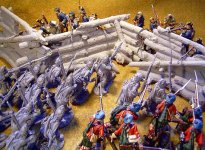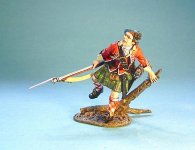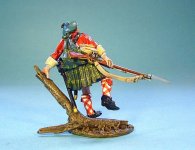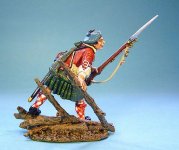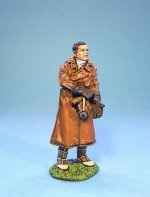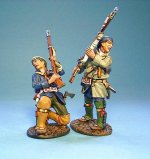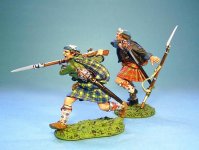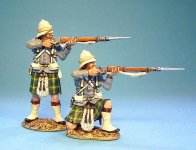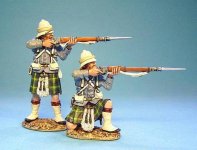Good morning from a chilly Northern California, where Fall / Winter is beginning to arrive.
Here are the releases from the Chicago show, John previewed the prototypes them at our Saturday Meet and Greet.
I have been looking forward to the new series on Fort Carillon, I think this will be an outstanding release.
Sales of the new Knights of the Skies series have been excellent and now with the release of the first pilot figure, it will get even more exciting. Do not wait to long to pick up the Sopwith Camel, and especially do not wait until the series has been fully rolled out, as you may miss out.
With a bit of luck, should have these on www.sierratoysoldier.com later this morning. As always hope you enjoy these as much as I do.
Best regards
Mike
Sierra Toy Soldier Company
BATTLE Of FORT CARILLON, TICONDEROGA, 8th JULY 1758
The Battle of Fort Carillon, was fought on July 8, 1758
In the battle, which took place primarily on a rise about three-quarters of a mile (one km) from the fort itself, a French army of about 4,000 men under General Louis-Joseph de Montcalm and the Chevalier de Levis decisively defeated an overwhelmingly numerically superior force of British troops under General James Abercrombie, which frontally assaulted an entrenched French position without using field artillery.
Abercrombie, confident of a quick victory, ignored several viable military options, such as flanking the French breastworks, waiting for his artillery, or laying siege to the fort. Instead, relying on a flawed report from a young military engineer, and ignoring some of that engineer's recommendations, he decided in favor of a direct frontal assault on the thoroughly entrenched French, without the benefit of artillery.
The battle was the bloodiest of the war, with over 3,000 casualties suffered, of which over 2,000 were British
The 42nd Regiment, known as the Black Watch, paid dearly with the loss of many lives and many severely wounded. More than 300 men (including 8 officers) were killed, and a similar number were wounded, representing a significant fraction of the total casualties suffered by the British.
TIC-03
BATTLE Of FORT CARILLON
TICONDEROGA, 8th JULY 1758
42nd REGIMENT OF FOOT
2 Figures Advancing
(2pcs)
Not Limited Edition
Retail us$70
TIC-04
BATTLE Of FORT CARILLON
TICONDEROGA, 8th JULY 1758
42nd REGIMENT OF FOOT
1 Figure Advancing#4
(1pcs)
Not Limited Edition
Retail us$35
TIC-05
BATTLE Of FORT CARILLON
TICONDEROGA, 8th JULY 1758
42nd REGIMENT OF FOOT
1 Figure Advancing#5
(1pcs)
Not Limited Edition
Retail us$35
KNIGHTS OF THE SKIES
Captain Arthur Roy Brown DSC and bar RNAS (23 December 1893 – 9 March 1944) was a Canadian World War I flying ace.
Brown will of course be ever famous for his involvement in the death of Manfred von Richthofen on 21st April 1918
What is less well known, but perhaps much more impressive, is that Brown never lost a pilot in his flight during combat. This was due largely to his demands for a "breaking in" period in which new pilots flew over the fights just to see how they worked.
ACE-10P
KNIGHTS OF THE SKIES
CAPTAIN ROY BROWN
(1pcs)
NOT LIMITED
Retail us$30
On the morning of 21 April, No. 209 was involved in a combat patrol when they were set upon by planes of Jagdstaffel 11, led by Manfred von Richthofen, the "Red Baron". A newcomer to No. 209, Brown's school friend, Lt. Wop May, had been instructed to stay clear of any fight and watch. May noticed an enemy pilot doing the same thing. The Red Baron's cousin, Lt. Wolfram von Richthofen, who had been given the same instructions as May. May attacked Wolfram and soon found himself in the main fight, spraying bullets everywhere until his guns jammed. May dived out of combat, and Manfred von Richthofen gave chase down to ground level. Brown saw May in trouble and dived steeply in an attempt to help out. His attack was necessarily of fairly short duration, and he was obliged to climb steeply to avoid crashing into the ground, losing sight of both Richthofen and May.
What happened next remains controversial to this day, but it seems highly probable that Richthofen turned to avoid Brown's attack, and then, instead of climbing out of reach of ground fire and prudently heading for home, remained at low altitude and resumed his pursuit of May, who was zig-zagging to throw off another attack. May and Richthofen's route now took them at low level right over some of the most heavily defended points of the Somme. Some have suggested he became lost, as the winds that day were blowing the "wrong way", towards the west, and the fight had slowly drifted over to the Allied side. The front was also in a highly fluid state at the time, in contrast to the more common static trench lines earlier in the Great War, and landmarks can be confusing in very low level flight.
Australian Army machine gunners on the ground fired at Richthofen, who eventually crashed near the Australian trenches. Upon viewing Richthofen's body the following day, Brown wrote that "there was a lump in my throat. If he had been my dearest friend, I could not have felt greater sorrow". His initial combat report was that the fight with Richthofen was "indecisive" - this was altered by his commanding officer to "decisive". In any case, Brown was officially credited with the kill by the RAF, and received a Bar for his DSC.
There is some research suggesting that von Richthofen was killed by a single bullet fired by an anti-aircraft machine gunner, perhaps Sergeant Cedric Popkin of the Australian 24th Machine Gun Company.
THE BATTLE OF THE PLAINS OF ABRAHAM 1759
ALSO SUITABLE FOR “RETURN TO MONONGAHELA” SERIES.
The first of several new sets of French Marines, in Campaign dress. There have been many requests for more French troops for “Braddocks Defeat”, and these will be perfect additions for those collecting the Monongahela series.
QFM-06
BATTLE OF THE PLAINS OF ABRAHAM,
13th September 1759,
French Marines in Campaign Dress, At Ready
(2pcs)
Limited Edition 750
Retail us$58
THE JACOBITE REBELLION 1745
James Johnstone summed up the highland fighting method
“Their manner of fighting is well adapted for brave but undisciplined men. They advance with rapidity, discharge their pieces when within musket-length of the enemy, and then, throwing them down, draw their swords, and holding a dirk and target, dart with fury on the enemy through the smoke and fire….”
Another quote by Sullivan describes the tactics
“Any man that served with Highlanders, knows that they fire but one shot, abandon their firelocks after. If there be any obstruction that hinders them from going on the enemy, all is lost; they don’t like to be exposed to the enemy’s fire, nor can they resist it, not being trained to charge(reload) as fast as regular troops, especially the English, which are the troops in the world that fires best.”
JR-19
THE JACOBITE REBELLION 1745
Highlanders Charging with musket #2
2 Figures (2pcs)
Limited Edition 500
Retail us$70
THE FIRST SUDAN WAR 1884-1885
There were seven companies at Tamai, and they formed the left side and front corner of General Buller’s square. Their “machine-like” volleys of gun fire were one of the main reasons that the pressure was relieved on the second British square which had been broken by the Dervish onslaught.
This will be the first of two firing sets for the Gordon Highlanders.
GDH-04
THE FIRSTSUDAN WAR 1884-1885
GORDON HIGHLANDERS
2 Figures Firing#1 (2pcs)
NOT Limited Edition
Retail us$62 )
These Figures are not “fully equipped”….. under the kilt
THE BATTLE OF CHIPPEWA July 5th 1814
Infantry Pioneers had much the same purpose as modern combat engineers. On the march, they followed the advance guard and made quick repairs to bridges and roads. In attacks on fortified positions, they led the way to chop gaps in the enemy’s abbatis and palisades. During retreats, they marched with the rear guard, destroying bridges and obstructing roads. In camp, they improved the site and improvised roads.
This demanding work required strong, reliable, and intelligent men.
Scott’s pioneers proved so useful that the practice was extended to all infantry regiments in 1815 and continued in use through the Mexican war.
USCH-07
THE WAR OF 1812
The Battle of Chippawa, 5th July 1814
Scott’s Brigade
Pioneer, Corporal
(1pc)
Not Limited Edition
Retail us$30
RETIREMENTS
WIM-07
WIM-08
QBGATE
QB-23
Hope you liked this set of releases as much as I do.
Best regards
Mike
Sierra Toy Soldier Company
Here are the releases from the Chicago show, John previewed the prototypes them at our Saturday Meet and Greet.
I have been looking forward to the new series on Fort Carillon, I think this will be an outstanding release.
Sales of the new Knights of the Skies series have been excellent and now with the release of the first pilot figure, it will get even more exciting. Do not wait to long to pick up the Sopwith Camel, and especially do not wait until the series has been fully rolled out, as you may miss out.
With a bit of luck, should have these on www.sierratoysoldier.com later this morning. As always hope you enjoy these as much as I do.
Best regards
Mike
Sierra Toy Soldier Company
BATTLE Of FORT CARILLON, TICONDEROGA, 8th JULY 1758
The Battle of Fort Carillon, was fought on July 8, 1758
In the battle, which took place primarily on a rise about three-quarters of a mile (one km) from the fort itself, a French army of about 4,000 men under General Louis-Joseph de Montcalm and the Chevalier de Levis decisively defeated an overwhelmingly numerically superior force of British troops under General James Abercrombie, which frontally assaulted an entrenched French position without using field artillery.
Abercrombie, confident of a quick victory, ignored several viable military options, such as flanking the French breastworks, waiting for his artillery, or laying siege to the fort. Instead, relying on a flawed report from a young military engineer, and ignoring some of that engineer's recommendations, he decided in favor of a direct frontal assault on the thoroughly entrenched French, without the benefit of artillery.
The battle was the bloodiest of the war, with over 3,000 casualties suffered, of which over 2,000 were British
The 42nd Regiment, known as the Black Watch, paid dearly with the loss of many lives and many severely wounded. More than 300 men (including 8 officers) were killed, and a similar number were wounded, representing a significant fraction of the total casualties suffered by the British.
TIC-03
BATTLE Of FORT CARILLON
TICONDEROGA, 8th JULY 1758
42nd REGIMENT OF FOOT
2 Figures Advancing
(2pcs)
Not Limited Edition
Retail us$70
TIC-04
BATTLE Of FORT CARILLON
TICONDEROGA, 8th JULY 1758
42nd REGIMENT OF FOOT
1 Figure Advancing#4
(1pcs)
Not Limited Edition
Retail us$35
TIC-05
BATTLE Of FORT CARILLON
TICONDEROGA, 8th JULY 1758
42nd REGIMENT OF FOOT
1 Figure Advancing#5
(1pcs)
Not Limited Edition
Retail us$35
KNIGHTS OF THE SKIES
Captain Arthur Roy Brown DSC and bar RNAS (23 December 1893 – 9 March 1944) was a Canadian World War I flying ace.
Brown will of course be ever famous for his involvement in the death of Manfred von Richthofen on 21st April 1918
What is less well known, but perhaps much more impressive, is that Brown never lost a pilot in his flight during combat. This was due largely to his demands for a "breaking in" period in which new pilots flew over the fights just to see how they worked.
ACE-10P
KNIGHTS OF THE SKIES
CAPTAIN ROY BROWN
(1pcs)
NOT LIMITED
Retail us$30
On the morning of 21 April, No. 209 was involved in a combat patrol when they were set upon by planes of Jagdstaffel 11, led by Manfred von Richthofen, the "Red Baron". A newcomer to No. 209, Brown's school friend, Lt. Wop May, had been instructed to stay clear of any fight and watch. May noticed an enemy pilot doing the same thing. The Red Baron's cousin, Lt. Wolfram von Richthofen, who had been given the same instructions as May. May attacked Wolfram and soon found himself in the main fight, spraying bullets everywhere until his guns jammed. May dived out of combat, and Manfred von Richthofen gave chase down to ground level. Brown saw May in trouble and dived steeply in an attempt to help out. His attack was necessarily of fairly short duration, and he was obliged to climb steeply to avoid crashing into the ground, losing sight of both Richthofen and May.
What happened next remains controversial to this day, but it seems highly probable that Richthofen turned to avoid Brown's attack, and then, instead of climbing out of reach of ground fire and prudently heading for home, remained at low altitude and resumed his pursuit of May, who was zig-zagging to throw off another attack. May and Richthofen's route now took them at low level right over some of the most heavily defended points of the Somme. Some have suggested he became lost, as the winds that day were blowing the "wrong way", towards the west, and the fight had slowly drifted over to the Allied side. The front was also in a highly fluid state at the time, in contrast to the more common static trench lines earlier in the Great War, and landmarks can be confusing in very low level flight.
Australian Army machine gunners on the ground fired at Richthofen, who eventually crashed near the Australian trenches. Upon viewing Richthofen's body the following day, Brown wrote that "there was a lump in my throat. If he had been my dearest friend, I could not have felt greater sorrow". His initial combat report was that the fight with Richthofen was "indecisive" - this was altered by his commanding officer to "decisive". In any case, Brown was officially credited with the kill by the RAF, and received a Bar for his DSC.
There is some research suggesting that von Richthofen was killed by a single bullet fired by an anti-aircraft machine gunner, perhaps Sergeant Cedric Popkin of the Australian 24th Machine Gun Company.
THE BATTLE OF THE PLAINS OF ABRAHAM 1759
ALSO SUITABLE FOR “RETURN TO MONONGAHELA” SERIES.
The first of several new sets of French Marines, in Campaign dress. There have been many requests for more French troops for “Braddocks Defeat”, and these will be perfect additions for those collecting the Monongahela series.
QFM-06
BATTLE OF THE PLAINS OF ABRAHAM,
13th September 1759,
French Marines in Campaign Dress, At Ready
(2pcs)
Limited Edition 750
Retail us$58
THE JACOBITE REBELLION 1745
James Johnstone summed up the highland fighting method
“Their manner of fighting is well adapted for brave but undisciplined men. They advance with rapidity, discharge their pieces when within musket-length of the enemy, and then, throwing them down, draw their swords, and holding a dirk and target, dart with fury on the enemy through the smoke and fire….”
Another quote by Sullivan describes the tactics
“Any man that served with Highlanders, knows that they fire but one shot, abandon their firelocks after. If there be any obstruction that hinders them from going on the enemy, all is lost; they don’t like to be exposed to the enemy’s fire, nor can they resist it, not being trained to charge(reload) as fast as regular troops, especially the English, which are the troops in the world that fires best.”
JR-19
THE JACOBITE REBELLION 1745
Highlanders Charging with musket #2
2 Figures (2pcs)
Limited Edition 500
Retail us$70
THE FIRST SUDAN WAR 1884-1885
There were seven companies at Tamai, and they formed the left side and front corner of General Buller’s square. Their “machine-like” volleys of gun fire were one of the main reasons that the pressure was relieved on the second British square which had been broken by the Dervish onslaught.
This will be the first of two firing sets for the Gordon Highlanders.
GDH-04
THE FIRSTSUDAN WAR 1884-1885
GORDON HIGHLANDERS
2 Figures Firing#1 (2pcs)
NOT Limited Edition
Retail us$62 )
These Figures are not “fully equipped”….. under the kilt
THE BATTLE OF CHIPPEWA July 5th 1814
Infantry Pioneers had much the same purpose as modern combat engineers. On the march, they followed the advance guard and made quick repairs to bridges and roads. In attacks on fortified positions, they led the way to chop gaps in the enemy’s abbatis and palisades. During retreats, they marched with the rear guard, destroying bridges and obstructing roads. In camp, they improved the site and improvised roads.
This demanding work required strong, reliable, and intelligent men.
Scott’s pioneers proved so useful that the practice was extended to all infantry regiments in 1815 and continued in use through the Mexican war.
USCH-07
THE WAR OF 1812
The Battle of Chippawa, 5th July 1814
Scott’s Brigade
Pioneer, Corporal
(1pc)
Not Limited Edition
Retail us$30
RETIREMENTS
WIM-07
WIM-08
QBGATE
QB-23
Hope you liked this set of releases as much as I do.
Best regards
Mike
Sierra Toy Soldier Company


